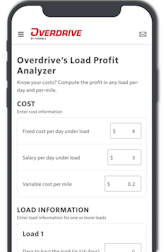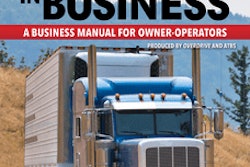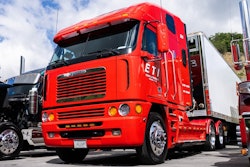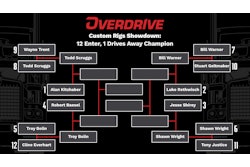Many fleet drivers think of owning a truck as a step up. But ownership can be a double-edged sword. Being successful – or not – depends upon how one handles the business of ownership. As Todd Spencer, vice president of the Owner-Operator Independent Drivers Association, puts it, “To be successful you have to be a businessman first and a truck driver second.”
There is a certain amount of freedom involved in ownership, but with freedom comes the daily, even hourly attention to the myriad of details the successful business owner is required to maintain. Deciding to become an owner-operator without understanding the responsibilities it entails is a surefire way to fail.
The most daunting aspect for many is coming up with a down payment. Many lending institutions are not partial to investments in rolling stock, and the situation gets worse if your credit history leaves something to be desired.
Financing through a dealer may be an option. But throw a bad credit rating into that mix, and your chances plummet there as well. For this reason, Todd Amen of American Truck Tax in Denver believes, “The lease-purchase rather than buying is a good entry-level strategy.” If you have the down payment for a new or used vehicle and your credit rating is good, owning is a definite possibility. But deciding to buy based upon the mere fact that you have a down payment and a good credit rating is like buying a horse by looking only at its teeth.

The difficulties of ownership or lease-purchasing are worsened by the current economic climate. Freight rates have been stagnant since deregulation made it possible for individuals to become motor carriers by getting an ICC number. Fuel prices fluctuate wildly, generally upward, and freight can be very slow in an uncertain economy. Buying a lot of chrome and horsepower may make you feel good, but is not necessarily the most sound business decision. Buying a used truck in a lease-purchase deal can be even riskier if you have not done your homework on the truck’s mechanical condition and all aspects of the agreement.
Like the owner-operator, the lease-operator may have to survive on very slim margins in the beginning. Every penny you save because you have a business plan well in advance of purchase – a business plan you stick to – will preserve the freedom you are buying with your sweat and money.
There are success stories out there, even considering the high cost of doing business and the tight financing market. Trucking has always been and will always be a cost and labor intensive business, as a glance at the profit margins of even the most successfully run companies will prove. Three or 4 percent profit margins are the rule rather than the exception. You will probably find that you take home a little less than the typical fleet driver in the same type of operation.
Remember, salary is not the same as profit. You need to pay yourself a living wage out of your settlements. Only then will you be able to see if you are realizing a profit. In other words, if you do not itemize your salary as an expense, you will not be able to calculate profit. All truck expenses and all costs of doing business, including replacement cost of your truck, should be figured as a portion of your cents per mile.
And don’t be fooled by having seen owner-operators pull wads of cash out of their pockets to pay for fuel or meatloaf. Large wads of cash in the pocket do not always translate into having enough money in the bank to make your $1,300 or $1,400 a month new truck payments or pay the escrow your carrier will want or any of many unexpected and intangible expenses that continually arise.
The pitfalls of ownership and lease-purchasing are different. But the rewards are similar. Fleet drivers who want to own but have limited resources will be attracted to the lease-purchase agreement because carriers do not require a down payment.
The first step is to make sure you are entering a lease-purchase rather than a straight lease. A small security deposit and or escrow may be required, and payments are generally lower in lease-purchase deals when you are buying used equipment.
Great caution is also required to insure your agreement meets your expectations and will result in ownership at the end of the lease. The only way to understand the agreement totally is to take it to a lawyer and an accountant. “It is your right to take the lease to a lawyer and accountant of your choosing,” Amen says.
Carriers that will not give you a lease to take to the lawyer or that insist you use their accountant should be avoided. Not doing this may be the biggest mistake a prospective lease-operator can make. The trucking landscape is littered with drivers who have lost their investment when freight slowed.
Jeff Warta is a case in point. “I lost my truck after paying 46 of 48 payments when my carrier went bankrupt, and they repossessed my truck to help pay off creditors.”
Others, like John Wilson, have had trucks repossessed when freight slowed down during the winter. “They took my truck, and now I am in a long court battle to get it back,” says Wilson.
Other lease-operators discover they are not able to put the truck to work for another carrier when they want to make a change. Or, like Dave Williams, they discover that their truck is not worth the balloon buyout necessary to complete the purchase at the end of the lease. “I turned in my truck and walked away,” Williams says. Another common problem is that escrows do not get refunded, according to Spencer at OOIDA.
But not all lease-operators have experiences like these. Keith DeHaven went bankrupt as an owner-operator but has since lease-purchased five trucks, three of them through Highway Sales in Eagan, Minn.
DeHaven has worked his way up and now drives a late model 379 Pete with a C-15 Cat. “I drive the truck I want to drive and I have money in the bank,” DeHaven says. “You need a strong work ethic and a business plan to succeed with a lease-purchase.”
Whether you decide to lease-purchase your truck or have the resources to buy outright, you need that same strong work ethic and business plan.
One primary concern of that business plan is depreciation. “An owner-operator who acquires his truck through a lease-purchase program loses the flexibility that depreciation provides,” says Charles Cox, author of “Partners in Business,” a manual for owner-operators produced by Overdrive magazine and Volvo Trucks North America. “A buyer, as opposed to a lessor, has the option of expensing a large amount of money in the year he buys the truck. The lessor doesn’t have that flexibility. He can only deduct the amount of the monthly payment.”
The most obvious difference between owner-operators and lease-operators who do well and those who don’t is their degree of knowledge about themselves and the business of trucking.
There are very few places one can find this kind of information in one place. Certainly an article of this length can only scratch the surface. Freightliner has a program called “Route To Success” for those who buy one of their trucks. Overdrive’s “Partners In Business” manual can be obtained by calling (800) 633-5953. A prospective owner-operator can use this manual as a guide to his future without first having to buy a truck.
You might also consider using the services of a truck accounting firm like Truckers’ Home Office in El Paso, Texas. They provide tax services and a monthly accounting of expenses and settlements that will prove invaluable in remaining solvent.
Educating yourself before taking the leap has to be followed with strict diligence about finances. Making uninformed, emotional decisions and starting up without sufficient capital in reserve will turn your dream into a nightmare. The professional driver looking to be a professional owner-operator needs the patience to wait for the right time, the right carrier and the right financial situation before committing. Look hard before you leap.
A Quick Guide to Buying and Leasing








